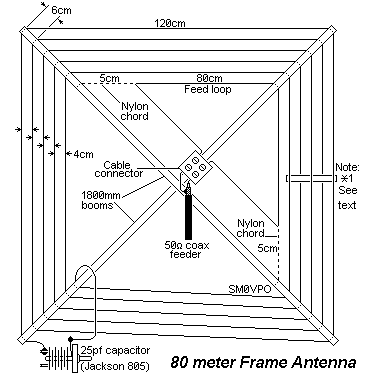| 80
Meter Frame Antenna
by Harry
Lythall (SM0VPO)
This project
was developed as a result of experiments to become QRV on 80 meters,
again, using the little balcony of mine.
I have now built several of these antennas with equal success
every time. The frame antenna may not be the most efficient but
it can get you QRV on 80 and is ideal for boats and holidays.
Construction

The construction
of the antenna is shown above and is a five turn loop of one cable
from 5 ampere mains cable.
The cable must have a multi-stranded conductor.
The antenna uses over 20 meters of the cable, so I stripped down
7 meters of 3-core cable and soldered the ends together. Construction
is otherwise quite straight forward if you follow the above drawing.
Note that all cable lengths shown are approximate.
The two
boom poles - I have used both cane and a plastic clad tin
(metalic) pipes, of the sort that are sold in garden shops. Both
worked very well in spite of the difference in materials.
If you do use metal booms then insert some form of insulation
in the holes before you pass wire through them. I used plastic
drinking straws from MacDonalds. This will prevent the metal from
digging into the cable insulation, as well as improving the insulation.
With the
dimensions shown each loop will be separated by 4 cm. The
natural capacity between the turns will tune the antenna to (about)
4.15 MHz, just above the 80 meter band. One of those Jackson 804
/ 805 VHF tuning capacitors with about 25pf will tune the antenna
down to 3.45 - 3.90 MHz. The tuning capacitor MUST be one with
a couple of millimeters between the plates. The antenna has a
very high Q so the voltage across the capacitor will be very high,
even with small QRP powers.
160 Meters
A capacitor
of 410 pf placed across the tuning capacitor move the antenna
frequency down to 1.9 MHz. This capacitor MUST be a high voltage
type. This antenna could get you QRV on 160 meters although efficiency
is likely to suffer, but Ok for local nets and the like.
Trimming
If the 80
meter antenna does not naturally fall on 4.15 MHz, or the tuning
capacitor is not centered on the band then some frequency adjustment
can be made to the final antenna.
If the frequency
is a little low and you need to increase it then some of
the self capacity must be removed. Thread a bit of plastic tube
between the wires of one side; IN, OUT, IN, OUT, IN. (See Note
*1 in the picture above)
Repeat on more than one side of the frame antenna if a larger
frequency increase is required. If the increase is still not enough
then insert two tubes in each side and slide them apart to get
a large increase.
If the frequency
is too high and you need to decrease it then some more
capacity must be added. Connect a high voltage capacitor across
the variable tuning capacitor. A short length of coaxial cable
is ideal. Cut the coaxial capacitor shorter to reduce to the required
capacity (increase the frequency).
(If you use this antenna for transmitting, do not be tempted to
make a 'gimmick' capacitor with two wires twisted together; it
will burn, even with a couple of watts of RF. This means that
you have added more losses.)

This
is only one of lots of interesting radio and antenna projects
that Harry Lythall,
SM0VPO, in Upplands Väsby, Sweden, has to offer
on his web site. A visit is highly recommended.
|





